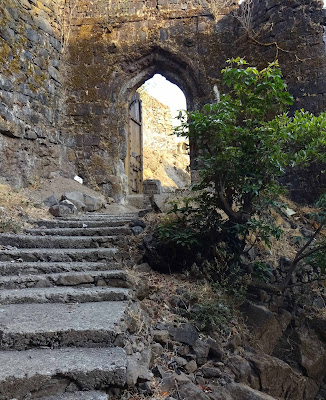Tuesday 5 November 2019
Friday 6 September 2019
In the Clouds - Walking up to the Highest Point
 |
| About an hour into the walk it began to rain, heavily at times, so we were walking along small waterfalls by the path, this water brought a lot of mud with it, erosion I suppose. |
 |
| the route up is intermittently a rocky path, surrounded by many hues of bright green... |
 |
| ...through a gushing stream on the way.... |
 |
| ...along the way we go up slick and slippery steps cut by ancients. |
 |
| There is water everywhere, brown with eroded soil. Where it can, it flows, otherwise it puddles. |
 |
| Irrespective of the vegetation, moss and fern every bit of the way make the path slippery. More so when coming down when one has to often sit and descend. |
 |
| On the route down we cross the Kanheri Caves. Now decrepit and amateurishly renovated, these ancient Buddhist Caves form an elaborate complex which have withstood the ravages of time over centuries. |
 |
| It was lovely walk and a wonderful experience. “After the rain, the sun will reappear. There is life. After the pain, the joy will still be here.” ― Walt Disney Company |
Thursday 29 August 2019
Green - the Colour of Monsoon
 |
When the green woods laugh with the voice of joy, And the dimpling stream runs laughing by; When the air does laugh with our merry wit, And the green hill laughs with the noise of it.
|
 |
| Karnala Fort seen from the air, draped in green. Everything wears a gown of green in the monsoon, the green is bright, verdant, lush and covers every visible inch. Water is life. |
 |
| Though the primary colour is green, other colours emerge also. this single stalk of balsam amidst the grass is possibly the precursor of a riot of colour. |
 |
| In the forest multi-hued flowers grow in the lush vegetation and lend a colourful air to the sea of green. |
 |
| These karvi flowers grow after seven years, some mysterious biological clock ticks away the time and they flower together, entire hillsides take on a purple hue. |
 |
| It is a time for courting, this Malabar Gliding frog calls to its mate... |
 |
| ...and having found her, they mate, laying their eggs in a blob of foam over water so that the tadpoles fall into the water when they hatch. |
 |
| A cicada moults under cover of darkness and waits for its wings to dry before it commences its characteristic buzz |
 |
| The unwary beware, along with the prey come the predators, here a Malabar Pit Viper lies in ambush , waiting for that delicious frog to pass by. |
 |
| Malabar Pit Vipers are of many colours (morphs as they are known), green and brown are the more common colours. |
 |
| Everywhere everything is growing, a seed is left behind by a bird and a fern grows in a wall |
 |
| Water everywhere.... it collects in old buildings like this derelict but magnificent cathedral in Vasai... |
 |
| ...and wets the fresh plants and fallen wood in the forest, water is the giver and taker of life. |
Wednesday 29 May 2019
Sunrise Atop Korigarh
 |
| Each and every day we are blessed with on this Earth begins with one. We may not yet be awake, and it is sometimes hidden from view by cloud, but it is there nonetheless. -anonymous |
Subscribe to:
Posts (Atom)





























